
A lab functioning out of what was once a toilet, an institute without an auditorium, classes running out of portacabins — as Delhi University prepares for a fresh influx of students, the need for better infrastructure is being felt now more than ever. What’s more: For the first time in a decade, DU colleges have increased their student strength, after the Ministry of Human Resource Development (MHRD) mandated a 25% quota for students from the economically weaker section (EWS).
This year, the university has increased seats by 10%, which means around 6,000 seats are being added to the current strength of 56,000. In 2020, 15% more seats will be added.
Why funding has hit expansion
* An issue that is affecting expansion is lack of funds, with DU and UGC locked in a funding battle. A new system of funding, Higher Education Funding Agency (HEFA), is replacing the older UGC grants model to promote internal resource generation. * Under HEFA, DU will have to pay 10% of the principal amount, while 90% is payable by the government. Amid resistance, the university is yet to sign an MoU with MHRD and UGC. Till such time, funds will not be released. * Earlier this year, colleges were asked to draw up a programme-wise seat matrix and financial requirements to meet expansion. Colleges are bracing themselves for the eventual funds reaching them in the form of a loan instead of a grant. * “It is understandable, the government wants to push colleges towards output and returns through research. However, colleges are barely making ends meet so it will definitely be a challenge,” said the principal of a South Campus college. * In the meantime, the 12 colleges which are completely funded by the Delhi government have written to them with their requirements. However, these colleges are already being starved of funds by the latter, with their funds being withheld for the last few months due to a deadlock between the state government and the university over the constitution of governing bodies in colleges.
To understand the challenges the university is facing, The Indian Express looked closely at four colleges and spoke to faculty and heads at several others — and discovered how urgently expansion is required.
Another red flag is that there aren’t enough teachers — in 2008, after DU increased seats for OBC category students, DUTA president Rajib Ray said around 4,400 teachers were supposed to be recruited to ensure enough staff. That never happened, as roughly 2,000 teaching posts are yet to be filled.
This essentially means that when colleges open in July, students will be greeted with more sections per course, more classes, less classroom and lab space, and a slim chance of getting a hostel seat.
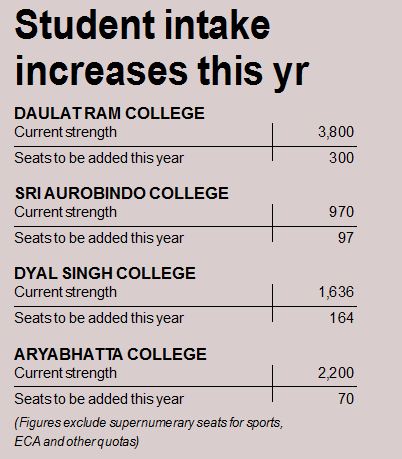
To fix this, a university official said, every college is making estimates of requirements and writing to respective funding agencies for assistance.
“A rough estimate is that smaller colleges which have around 550 students will require 10-15 new teachers. In colleges with over 5,000 students, requirement will go up to around 50 new teachers. The effect will be felt acutely four years from now, when 15% more students are admitted. Infrastructure crunch, however, will be felt from the first year itself,” the official told The Indian Express.
Rajesh Jha, an elected member of the Executive Council (EC), DU’s highest decision-making body, admitted that there is limited space in laboratories and dearth of equipment. “In many courses and colleges, majority of teaching happens inside laboratories. How will they manage? Are we trying to give quality education or just handing out degrees for the sake of it?” he said.
Former EC member Abha Dev Habib highlighted the dearth of non-teaching staff. “From admission to examination, non-teaching staff are involved everywhere. It is unfortunate that the government is rushing EWS expansion without providing grants for expansion of infrastructure and hiring teaching and non-teaching staff,” she said.
At the four colleges The Indian Express visited, the problems manifested in many ways.
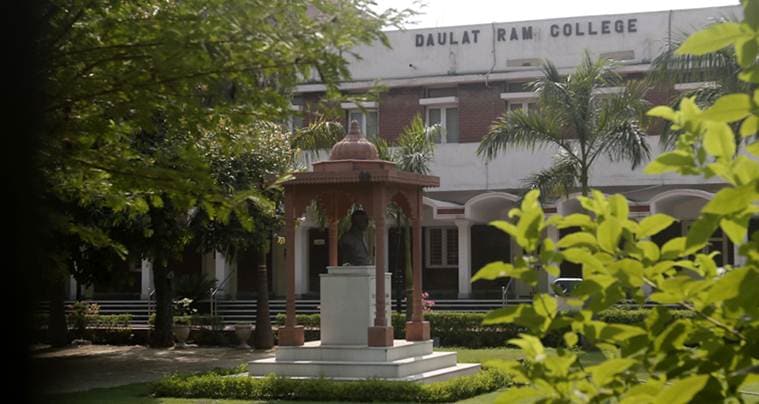
Daulat Ram College
Makeshift arrangements to stretch resources for 3,800 students are ubiquitous at the college. A wooden partition runs through its erstwhile seminar hall, so it can function as two classrooms. What used to be a toilet now houses seven stoves and a refrigerator to function as a laboratory for the Nutrition and Health Education Department. The sprawling canteen on the ground floor has been shifted out and the space is being used as a conference hall.
On the terrace, semi-permanent porta cabin structures have been set up to function as laboratories and teaching rooms for the psychology, biochemistry and physics departments. In empty spaces in the corridor on the ground floor, six semi-permanent classrooms have been set up.
“We are saturated and don’t have room for any more improvisation,” said Principal Dr Savita Roy.
To accommodate the student influx in 2008, the college had received over Rs 9 crore from the University Grants Commission (UGC), which was never utilised. “The process was in limbo for a long time. When I took charge as the principal in 2014, I created plans for new structures. But permission from the MCD is not in. We are going to have to return the amount, which will be a disaster,” said Roy.
In 2016, the college extended its class hours to make more use of classrooms. Classes now begin at 8 am instead of 9 am and end at 5 pm instead of 3.30 pm, increasing teaching time by 12 hours per week.
After expansion, the college will find itself with more than 100 students in programmes like BA (Hons) Economics, BA (Hons) Political Science and BA (Hons) Hindi.
“Before OBC reservation expansion, we had 28 students in a zoology class. With this year’s 10% expansion, we will have 51. It’s almost double, but labs and staff remain the same. We will have to create more sections,” said Roy.
This will prove to be a challenge, since the college has over 120 teaching vacancies. Out of the 188 teachers in the college, only 58 are permanent, and the rest ad hocs. The English department has 15 teachers — 13 of them ad hoc.
The hostel manages to accommodate only 200 students, and the problem will become more acute this year.
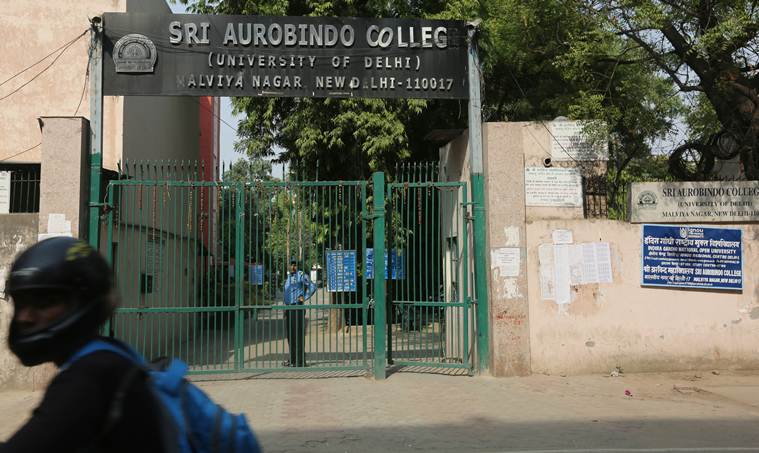
Sri Aurobindo College
It has been 47 years since the college was established, yet it does not have an auditorium or a proper sports field. It shares half its campus with a government school.
Classrooms are smaller than those in most DU colleges, not equipped to accommodate more than 50 students. Its seminar room can accommodate just over 100. Plus half the infrastructure is shared with the college’s evening counterpart.
“Evening colleges are ideally supposed to start at 5-6 pm, but they start much earlier, while morning classes are on. Students will increase in both colleges, so how will we manage? Even now, in BCom (P), there are so many students (around 270) that 20 rooms are needed, but they are managing with 12 classrooms. Class timings are being stretched from 8 am to 5 pm. The MHRD took the decision but should also have released funds,” said Hansraj Suman, a teacher.
In 2010-11, the college renovated 40 classrooms, but there has been stagnation since. Principal Vipin Aggarwal said the college meant to build portacabins, but work hasn’t started yet due to governing body issues.
The college will add 97 seats to its already existing strength of 970 seats this year.
“Suppose we have a class strength of 66 right now, and we need to expand by 25% to 80 or 85 students (by next year), we can’t accommodate them in one class. Then we’ll have to make two sections, which means double the workload. Our original faculty strength was 102. During the OBC expansion, we were sanctioned 56 or 57 additional teaching posts, but we only got 28 or 29, and that too on ad hoc basis,” he said.
For now, the college is planning to increase lectures and reduce tutorial classes to deal with more students.
“Most teachers only take classes five days a week and tutorials on Saturdays. This time we will have proper classes on Saturday as well. We will request some teachers to take extra classes and increase strength of tutorial class from about 15 students to 20-25 students, so more extra classes can take place,” the official said.
Suman said the workload of extra classes would fall on ad hoc teachers since they are not in a position to say no.DU Vice-Chancellor Yogesh Tyagi and registrar Tarun Das did not respond to calls and messages seeking a comment.
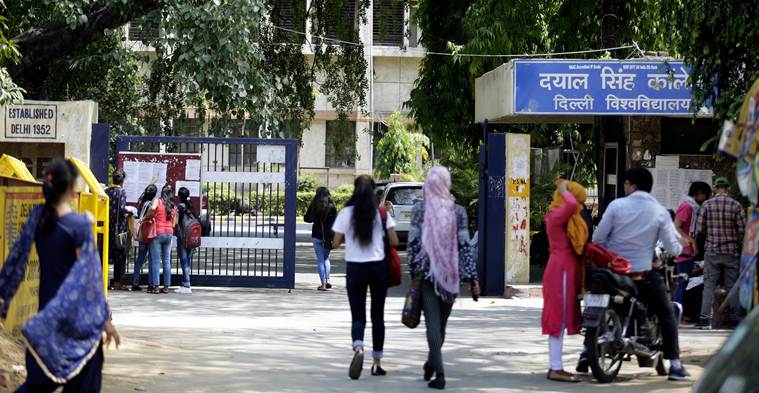
Dyal Singh College
Embroiled in a tussle with the Dyal Singh (Evening) College which now also operates during morning hours, this college is not new to problems. In 2017, the morning and evening college principals got into a spat when the latter started taking classes at an under-construction building, which the former said was allegedly built on land meant for a sports ground.
The college has 10 bamboo-based classrooms and porta cabins. It has a small library and no auditorium. The geography department, for example, has two small labs which barely accommodate 40 students, even though the strength of just one batch is double this number. Teachers said that during the monsoon, labs get flooded and expensive equipment is ruined.
“There is such a dearth of space that the administration put partitions in classrooms to make space for tutorials. These rooms have just three-four benches and no doors, so noise from the corridor comes in. You can’t teach,” said P K Parihar, a teacher.
“Classrooms, even in the new block, have been designed to accommodate 40 students in honours courses, and around 60 students in pass courses. This number will rise this year, so where will they go?” he said.
Principal I S Bakshi accepted it would be a problem, but more so next year: “With this 10% increase, we will have to see whether sections need to be increased in theory classes or tutorial groups. Wherever manageable, we will try to avoid this. Next year, the issue will become more pressing.”
Bakshi said he had written to the UGC demanding around 40 additional staff when the full 25% expansion takes place next year. “We got 83 posts under OBC expansion, and of these, 41-42 teaching posts are still pending,” he said, hoping that these too will come through.
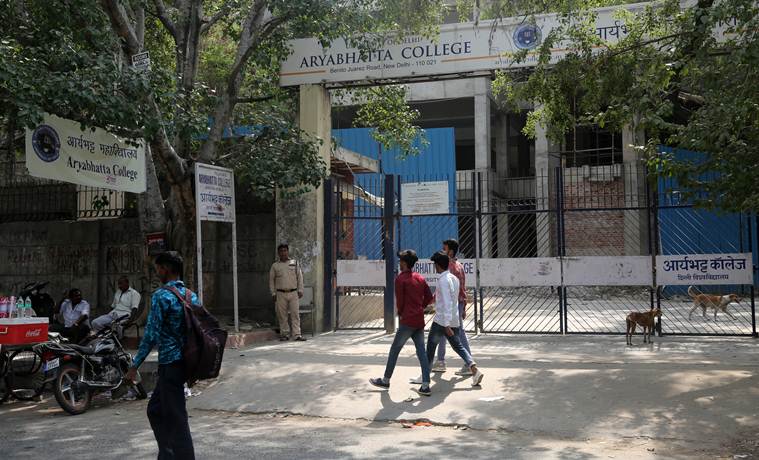
Aryabhatta College
Delhi University’s newest college, earlier called Ram Lal Anand (Evening) College, is still in the process of building itself up, but is faced with a different set of challenges.
Formed in the 2014-2015 academic year, the college’s main academic and administrative buildings are still under construction, but the administration is now rethinking its plans.
“Both buildings were to be four storeys tall, the outer structures are already complete but we plan to make them seven storeys high instead and have put the proposal before authorities,” said Principal Dr Manoj Sinha.
The college is trying to add core sciences to its 14 undergraduate courses but finds itself redirecting resources and infrastructure to expand the capacity of existing courses.
“We are in a much better position than older colleges where infrastructure is inadequate. Since we are starting with 2,200 students, we are more flexible. We will have to stretch resources but are awaiting the second phase of teacher recruitments from OBC expansion, which will give us 20 new teachers,” said Sinha.
Sinha, also the secretary of the DU principals’ association, questioned the way expansion is being carried out.
“What must really be questioned is the sequence in which this is playing out. Infrastructure and teaching capacity should be expanded first, but here we are, standing on our heads. The 10% increase will be squeezed in… we can only pray that in the coming year, colleges will receive resources from the government before the second phase,” he said.